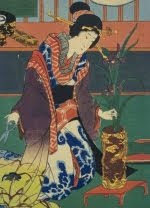I had planed to go on a vacation starting today, but since I don't feel too well I had to postpone the trip. To compensate I decided to treat myself to a week of flower practice - using a little time each day to meditate and create an ikebana arrangement with plant materials that can be found around my home.
Ikebana or Kado, meaning The Way of Flowers, is a contemplative practice. Working with plant materials is a grounding experience and teaches us to see what is before us.
Focusing on the shape of the container. Iris leaves and red berries.
Wood fired ceramic by Michiko Takahashi Nilsen.
I'm starting off with an arrangement using a new container by the Japanese-Norwegian ceramicist Michiko Takahashi Nilsen. At first site it looks like a round bowl. Studying the shape of it I found that the bowl is actually a bit like a boat. It has two quite distinct lines adding irregularity to the shape. I've used bended leaves of Siberian Iris to echo these lines, combining them with some red berries on vines that goes with the roundness and the warm brown colour. The container also has a wonderful pale bluish-gray inside that you can't see in the picture.

















